Artificial Intelligence (AI) is no longer a futuristic concept; it’s a driving force reshaping industries, economies, and our daily lives.
From automating complex tasks to powering innovative solutions in healthcare, finance, and marketing, AI’s impact is profound and rapidly expanding.
If you’re looking to understand where the world is heading and how to harness this powerful technology, grasping the latest AI market size statistics 2025 is absolutely crucial.
This detailed article will break down the latest facts and figures about the AI market size, exploring its growth trajectory, comparing it to other major sectors, highlighting key industry players, and revealing how people and businesses are adopting AI.
We’ll also dive into new insights from online communities, giving you a fresh perspective on what users are asking about this transformative technology.
Key Insights into the AI Market Size 2025:
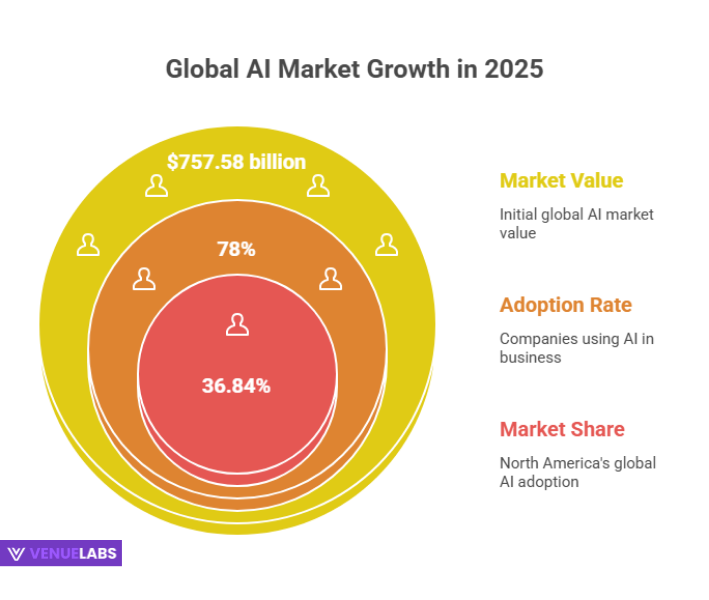
- Explosive Growth: The global AI market is worth $757.58 billion in 2025 and is set to reach $3.68 trillion by 2034, growing at a Compound Annual Growth Rate (CAGR) of 19.2%.
- Dominant Players: NVIDIA commands a staggering 92% of the generative AI GPU market, while Microsoft leads in foundational models and platforms with a 39% share.
- Widespread Adoption: Around 78% of global companies actively use AI in at least one business function, up from 50% in 2022.
- Booming Job Market: AI-related job postings in the U.S. surged by 25.2% year-over-year in Q1 2025, with AI Engineer roles growing fastest at 143.2%.
- North America Leads: This region holds over 36.84% of the global AI adoption market, driven by significant investments and supportive government policies.
- Software and Machine Learning Power: Software solutions held the biggest market share (51.40%) in 2024, and machine learning dominated technology segments (36.70%), with generative AI emerging as the fastest-growing segment (22.90% CAGR).
Let’s explore the dynamic world of AI and uncover how you can leverage its immense potential.
The AI Market: A Juggernaut of Growth from 2025 to 2034
The numbers speak for themselves: the AI market is experiencing unprecedented growth.
Here’s a detailed look at the projected global AI market growth:
| Sr. No. | Year | AI Market Size (USD) |
| 1 | 2024 | $638.23 billion |
| 2 | 2025 | $757.58 billion |
| 3 | 2026 | $900.00 billion |
| 4 | 2027 | $1,070.10 billion |
| 5 | 2028 | $1,273.42 billion |
| 6 | 2029 | $1,516.64 billion |
| 7 | 2030 | $1,807.84 billion |
| 8 | 2031 | $2,156.75 billion |
| 9 | 2032 | $2,575.16 billion |
| 10 | 2033 | $3,077.32 billion |
| 11 | 2034 | $3,680.47 billion |
Source: Precedence Research 2
This impressive growth trajectory means that AI is not just a passing trend; it’s a fundamental shift in how businesses operate and how technology is developed and applied.
AI in Perspective: Comparing Its Market Size to Other Industries
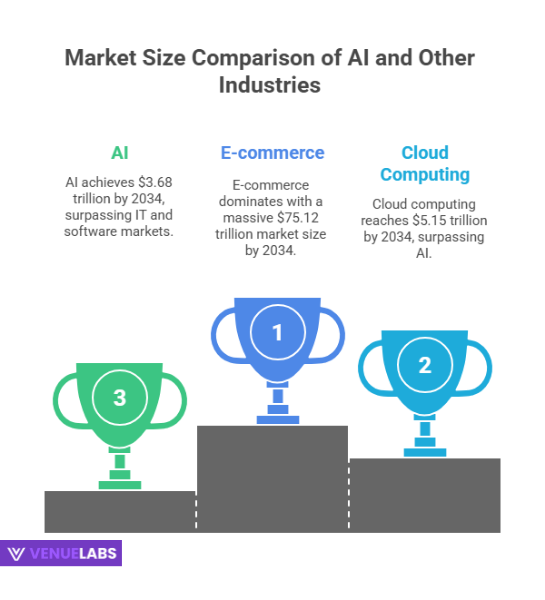
While AI’s growth is phenomenal, it’s helpful to compare its market size to other established and emerging sectors. This helps us understand its current standing and future potential.
- E-commerce: In 2025, the global e-commerce market is valued at a massive $21.62 trillion, far overshadowing AI’s $757.58 billion. However, by 2034, while e-commerce will reach $75.12 trillion, AI will hit $3.68 trillion, showing its impressive relative growth.
- IT Market: The broader IT market is expected to be $1.61 trillion in 2025, more than twice the size of AI. But by 2034, AI is projected to surpass IT, reaching $3.68 trillion compared to IT’s $2.98 trillion. This illustrates AI’s rapid ascent.
- Cloud Computing: Cloud computing stands at $912.77 billion in 2025, slightly larger than AI. However, by 2034, cloud computing will reach $5.15 trillion, surpassing AI’s $3.68 trillion, indicating its complementary and foundational role for AI.
- Software Market: In 2023, the global software market was $659.17 billion, just under AI’s 2025 value. By 2034, software will grow to $2.24 trillion, still significantly behind AI’s projected $3.68 trillion.
- Health & Wellness: This is a massive industry, valued at $6.87 trillion in 2025, almost nine times AI’s market size. Even by 2034, it’s forecasted to reach $11 trillion, remaining much larger than AI, though AI is making significant inroads in specific healthcare applications.
- Oil & Gas: Standing at $6.10 trillion in 2024, the oil and gas market is considerably larger than AI. By 2034, it will reach $8.79 trillion, maintaining a significant lead but growing at a much slower pace than AI.
Here’s a summary of these comparisons:
| Sr. No. | Sector | 2025/2024 Market Size (USD) | 2034 Market Size (USD) | Relative to AI in 2025 | Relative to AI in 2034 |
| 1 | AI | $757.58 billion | $3.68 trillion | – | – |
| 2 | E-commerce | $21.62 trillion | $75.12 trillion | Vastly larger | Still vastly larger |
| 3 | IT | $1.61 trillion | $2.98 trillion | More than double AI | Surpassed by AI |
| 4 | Cloud Computing | $912.77 billion | $5.15 trillion | Smaller than AI | Successfully surpasses AI |
| 5 | Software | $659.17 billion (2023) | $2.24 trillion | Slightly smaller than AI | Significantly smaller than AI |
| 6 | Health & Wellness | $6.87 trillion | $11 trillion | Nearly 9× AI | Still much larger than AI |
| 7 | Oil & Gas | $6.10 trillion (2024) | $8.79 trillion | Far larger | Still more than 2× AI |
What does this mean for you? While AI is smaller than some giant industries, its explosive growth trajectory means it’s rapidly gaining ground and influencing every sector. Investing in AI skills or solutions now positions you at the forefront of this transformation.
- Also read about: Perplexity AI Statistics
Who’s Powering the AI Revolution? Key Companies and Market Share
The AI landscape is highly competitive, with different companies dominating specific segments.
1. Generative AI GPU Market
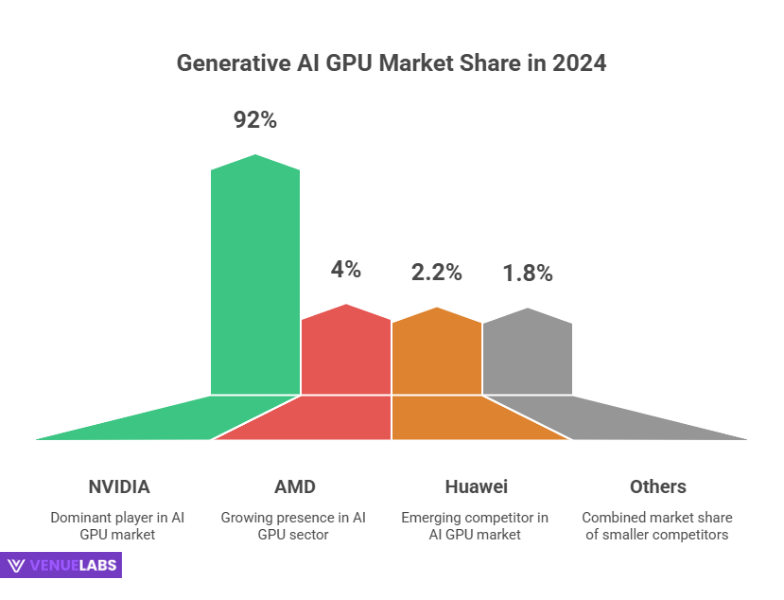
When it comes to the hardware that fuels advanced AI, particularly generative AI, one company stands out:
- NVIDIA holds an astonishing 92% share of the data center GPUs essential for generative AI workloads. This makes them a critical enabler of the current AI boom.
- AMD follows with a 4% market share in 2024, showing significant growth.
- All other competitors combined make up the remaining 4%.
| Sr. No. | Company | Share (%) |
| 1 | Nvidia | 92% |
| 2 | AMD | 4% |
| 3 | Huawei | 2.2% |
| 4 | Others | 1.8% |
2. Foundational Models and Platforms Market
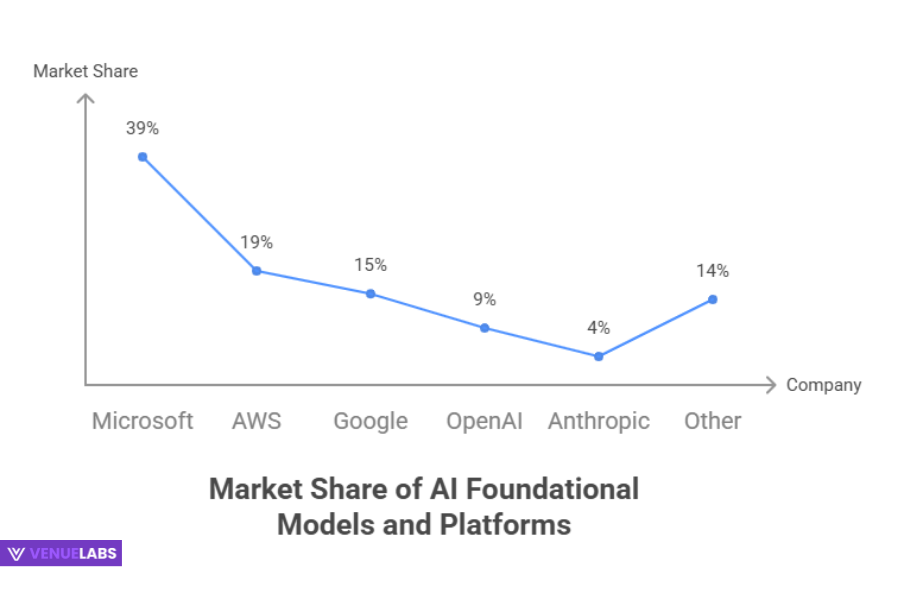
For the underlying AI models and the platforms that manage them, the competition is broader:
- Microsoft leads with a 39% market share, leveraging its vast cloud infrastructure and investments in AI.
- AWS comes in second with 19%.
- Google holds 15%, while OpenAI, a key innovator in generative AI, has a 9% share (excluding direct ChatGPT revenue).
| Sr. No. | Company | Share (%) |
| 1 | Microsoft | 39% |
| 2 | AWS | 19% |
| 3 | 15% | |
| 4 | OpenAI | 9% |
| 5 | Anthropic | 4% |
| 6 | Other | 14% |
3. Generative AI Services Market
When it comes to implementing and customizing generative AI for businesses, the market is more fragmented:
- Accenture leads with a 7.2% market share, backed by a $3 billion AI investment.
- Deloitte follows with 3.4%, having delivered over 700 generative AI projects.
- IBM holds 2.2%, focusing on its watsonx platform.
| Sr. No. | Company | Share (%) |
| 1 | Accenture | 7.2% |
| 2 | Deloitte | 3.4% |
| 3 | IBM | 2.2% |
| 4 | McKinsey & Company | 2.2% |
| 5 | BCG | 1.9% |
| 6 | Bain & Company | 1.0% |
| 7 | Infosys | 0.8% |
| 8 | Others | 81.3% |
Source: Statista
Your Opportunity: This breakdown shows that while a few giants dominate hardware and foundational models, there’s ample room for specialization in AI services and niche applications.
- Also read about: DeepSeek AI Statistics
Who’s Adopting AI? Demographics and Regional Trends
AI adoption varies across different groups of people and geographical regions. Understanding these patterns helps businesses tailor their AI strategies.
1. AI Adoption by Age
Younger generations are embracing AI much more readily:
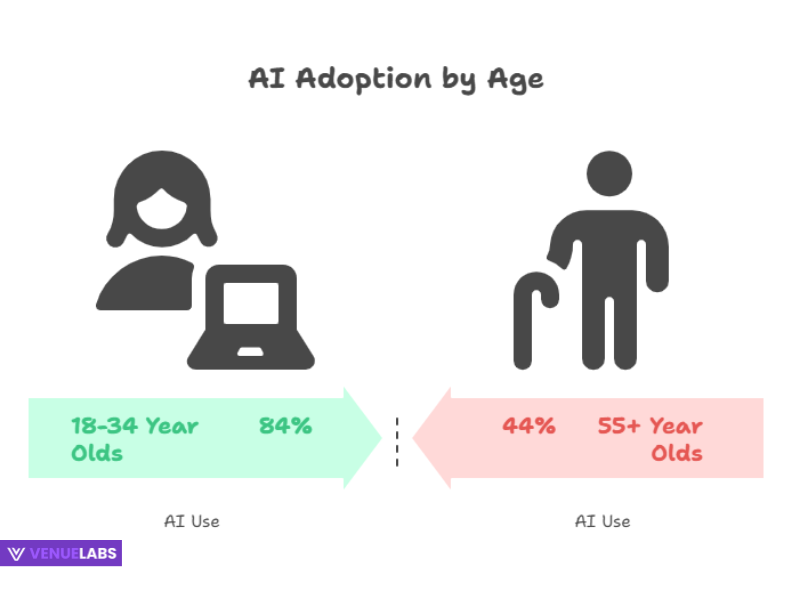
- A remarkable 84% of 18-34-year-olds use AI sometimes.
- In stark contrast, only 44% of those aged 55 and older use AI, a 40 percentage point difference.
- Formal AI training also follows this pattern: 56% of younger adults received some AI training, compared to just 20% of those 55 and older.
| Sr. No. | Age Group | % AI Use | % AI Training |
| 1 | 18-34 year olds | 84.00% | 56% |
| 2 | 35-54 year olds | 69% | 41% |
| 3 | 55 and older | 44% | 20% |
2. AI Market Distribution by Gender
Men generally show more enthusiasm for AI than women, though the gap varies by age:
- 57.3% of males aged 16-24 are excited about AI, making them the most interested group.
- The largest gender gap appears in the 65+ age group, with 35.4% of men interested versus 22% of women.
- Across all age groups, men (50%) were more likely to have used generative AI than women (37%) in 2024.
| Sr. No. | Age Group | Female (%) | Male (%) |
| 1 | 16-24 | 48.5% | 57.3% |
| 2 | 25-34 | 46.4% | 53.9% |
| 3 | 35-44 | 46.9% | 52.3% |
| 4 | 45-54 | 43.7% | 51.5% |
| 5 | 55-64 | 37.8% | 49.2% |
| 6 | 65+ | 22% | 35.4% |
Source: Fortune Business Insights
3. Global AI Adoption by Geography
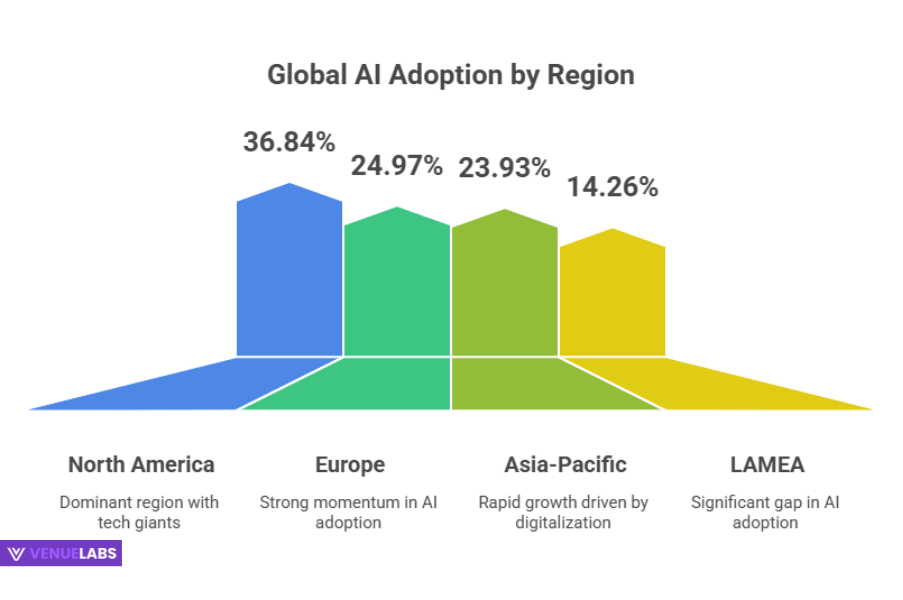
North America leads the charge in AI adoption:
- North America accounts for 36.84% of total global AI use, making it the dominant region. This is largely due to robust government support, significant investments in R&D, and the presence of major tech giants.
- Europe and Asia-Pacific combined contribute nearly half (48.9%) of global AI use, indicating strong momentum outside North America. The Asia-Pacific region, in particular, is expected to grow at the highest CAGR of 19.8% from 2025 to 2034, driven by rapid digitalization and government initiatives.
- LAMEA (Latin America, the Middle East, and Africa) has the lowest share at 14.26%, highlighting a significant gap in adoption between developed and emerging regions.
| Sr. No. | Region | % Share |
| 1 | North America | 36.84% |
| 2 | Europe | 24.97% |
| 3 | Asia-Pacific | 23.93% |
| 4 | LAMEA | 14.26% |
Your Takeaway: Tailor your AI solutions and marketing to these demographic and geographic realities. Focus on regions with high adoption or those poised for rapid growth.
The AI Job Market: A Landscape of New Opportunities
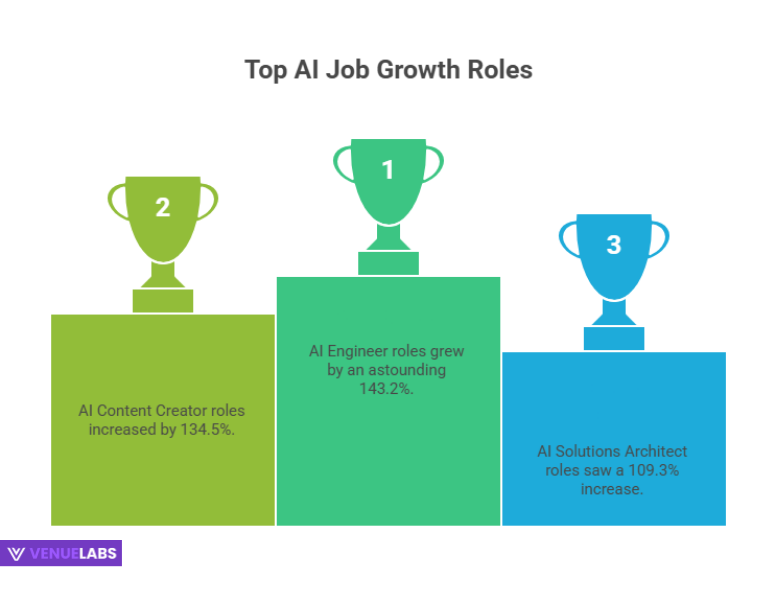
The AI boom is fundamentally changing the job market, creating new roles and demanding evolving skill sets.
- Soaring Demand: As of Q1 2025, the U.S. saw 35,445 AI-related positions, a remarkable 25.2% increase from Q1 2024.
- High Salaries: The median annual salary for AI roles rose to an impressive $156,998 in Q1 2025, underscoring the high value placed on AI expertise.
- Job Listing Surge: Mentions of AI in U.S. job listings increased by 114.8% in 2023, 120.6% in 2024, and 56.1% in Q1 2025.
- Fastest-Growing Roles:
- AI Engineer roles grew by an astounding 143.2%.
- AI Content Creator roles increased by 134.5%.
- AI Solutions Architect roles saw a 109.3% increase.
| Sr. No. | AI Job Role | Growth (%) |
| 1 | AI Engineer | 143.2% |
| 2 | AI Content Creator | 134.5% |
| 3 | AI Solutions Architect | 109.3% |
| 4 | Prompt Engineer | 95.5% |
| 5 | AI Systems Designer | 92.6% |
| 6 | AI Product Manager | 89.7% |
| 7 | AI Coach | 57.7% |
| 8 | AI Compliance Manager | 46.0% |
| 9 | Machine Learning Engineer | 35.3% |
| 10 | AI Strategist | 34.8% |
Global Job Growth: Asia recorded the highest increase in AI job listings year-over-year at 94.2%, followed by North America at 88.9%.
Workforce Impact: While AI might eliminate 92 million jobs by 2025, it’s expected to create 170 million new ones, resulting in a net gain of 78 million jobs. Workers with AI skills also earn 25% more than those without, highlighting the significant wage premium for AI capabilities.
AI in Business: Driving Efficiency and Innovation
Businesses are rapidly integrating AI into their operations, recognizing its immense potential to streamline processes, enhance decision-making, and unlock new growth avenues.
- High Adoption Rate: A report by McKinsey & Company reveals that 78% of companies use AI in at least one business function in 2025, a significant jump from 50% in 2022.
- Generative AI in Production: Crucially, 71% of companies regularly use generative AI in at least one business function in 2025, demonstrating quick adoption beyond mere experimentation.
| Sr. No. | Year | Use Of AI (%) | Use of Gen AI (%) |
| 1 | 2025 | 78% | 71% |
| 2 | 2024 | 72% | 65% |
| 3 | 2023 | 55% | 33% |
| 4 | 2022 | 50% | – |
| 5 | 2021 | 56% | – |
| 6 | 2020 | 50% | – |
| 7 | 2019 | 58% | – |
| 8 | 2018 | 47% | – |
| 9 | 2017 | 20% | – |
Economic Impact Across Sectors
AI’s economic benefits are far-reaching:
- Manufacturing: Could gain $3.78 trillion from AI by 2035.
- Financial Services: Could see an additional $1.15 trillion contribution.
- Professional Services: May earn $1.85 trillion.
- Wholesale and Retail: Could benefit from $2.23 trillion in additional economic output.
- Healthcare: AI in healthcare was valued at $15.4 billion and is expected to grow at a 37.5% CAGR from 2023 to 2030, revolutionizing diagnostics and treatment.
Regional Economic Gains: China and North America are projected to see the most significant economic boosts, with potential GDP increases of up to 26% and 14% respectively, by 2030.
Overcoming Challenges: The Road to Broader AI Implementation
Despite its immense potential, AI implementation faces hurdles:
- Data Accessibility: This is the most significant barrier, cited by 34% of companies.
- Skill Shortage: Limited AI skills, expertise, or knowledge are a primary challenge for 29% of organizations.
- Cost Concerns: Affect 29% of organizations.
- Insufficient Tools: 25% struggle with inadequate tools or platforms for model development.
These challenges highlight the need for accessible AI solutions, robust training programs, and continued investment in user-friendly AI development platforms.
- Also read about: Best Online AI Courses With Certificates
Deep Dive: Technology, Solutions, and End-User Insights
Let’s look at the specific segments driving the AI market.
1. Technology Insights
- Machine Learning (ML): Dominated the market with a 36.70% share in 2024. ML’s strength lies in automating tasks, improving accuracy, and processing vast data for pattern identification, leading to better decision-making.
- Generative AI: Expected to grow at a significant 22.90% CAGR, making it the fastest-growing segment. Generative AI’s ability to create new content (text, images, code) and automate tasks is transforming marketing, design, and software development.
Here’s the revenue by technology:
| Technology | 2022 (USD Billion) | 2023 (USD Billion) | 2024 (USD Billion) |
| Deep Learning | 165.98 | 196.83 | 233.69 |
| Machine Learning | 122.59 | 145.43 | 172.72 |
| NLP | 91.33 | 108.31 | 128.50 |
| Machine Vision | 74.22 | 87.57 | 103.33 |
2. Function Insights
- Operations: Led the market in 2024 with a 21.80% share. AI streamlines processes, automates tasks, and provides data-driven insights to boost efficiency and reduce costs across business functions.
- Cybersecurity: Expected to be the fastest-growing area with a 20.40% CAGR. AI enhances threat detection, automates responses, and improves overall security posture against increasingly sophisticated cyber threats.
3. Solution Insights
- Software: Held the biggest market share of 51.40% in 2024, signifying the prevalence of AI applications and platforms.
- Services: Dominated with a 39.2% share in 2024. AI as a service (AIaaS) offers convenience and scalability, making complex AI projects accessible to businesses without extensive in-house expertise.
Here’s the revenue by solution:
| Solution | 2022 (USD Billion) | 2023 (USD Billion) | 2024 (USD Billion) |
| Hardware | 109.20 | 129.66 | 154.22 |
| Software | 168.85 | 200.24 | 237.86 |
| Services | 176.08 | 208.23 | 246.14 |
End-User Insights
- BFSI (Banking, Financial Services, and Insurance): Emerged as a dominant force with a 19.60% market share in 2024. AI drives efficiency, enhances customer experience, and provides advanced fraud detection and risk assessment.
- Healthcare: Witnessing rapid growth with a 19.10% CAGR. AI significantly enhances patient care, improves operational efficiency, and streamlines administrative processes, from faster diagnoses to accelerated drug development.
Here’s the revenue by end-user:
| End User | 2022 (USD Billion) | 2023 (USD Billion) | 2024 (USD Billion) |
| Healthcare | 64.33 | 76.35 | 90.48 |
| BFSI | 72.59 | 86.13 | 102.26 |
| Law | 15.96 | 19.02 | 22.67 |
| Retail | 43.83 | 52.13 | 62.06 |
| Advertising & Media | 63.19 | 74.97 | 88.96 |
| Automotive & Transportation | 45.41 | 53.84 | 63.87 |
| Agriculture | 29.26 | 34.78 | 41.39 |
| Manufacturing | 43.44 | 51.58 | 61.49 |
| Others | 76.11 | 89.34 | 105.04 |
What Users Are Asking: New Insights from Quora and Reddit
To provide the most current and relevant perspective, we’ve gathered trending questions and discussions from online communities like Quora and Reddit regarding the AI market in 2025:
1. “Is the AI bubble going to burst soon, or is this growth sustainable?” Many users express concern about whether the rapid AI growth is a temporary bubble, similar to previous tech booms. They’re looking for signs of sustainability.
- Insight for You: While rapid growth always brings questions, the current AI expansion is driven by real-world applications and significant economic benefits across diverse industries. Unlike some past bubbles, AI is deeply integrated into essential business functions (78% company adoption) and is creating more jobs than it displaces. The sustained investment from tech giants and governments, combined with its tangible impact, suggests a more sustainable growth trajectory, albeit with inevitable market fluctuations.
2. “How can small businesses afford to implement AI given the market size and big company dominance?” Small business owners often feel overwhelmed by the scale of the AI market and the dominance of major players. They want practical advice.
- Insight for You: Small businesses can leverage AI through affordable “AI as a Service” (AIaaS) solutions, which offer pre-built AI capabilities without massive upfront investment. Focus on specific problems AI can solve, like automating customer service with chatbots, personalizing marketing, or optimizing supply chains. Many user-friendly, no-code/low-code AI tools are emerging, making AI accessible without needing a team of data scientists.
3. “What specific skills should I learn Individuals are keenly interested in adapting their careers to the evolving AI landscape.
- Insight for You: Beyond core programming (Python is key) and machine learning fundamentals, focus on skills like prompt engineering (how to effectively communicate with AI models), data ethics and governance (understanding responsible AI use), cloud AI platforms (AWS, Azure, Google Cloud), and domain-specific AI applications (e.g., AI in healthcare, finance). Soft skills like critical thinking, problem-solving, and adaptability are also highly valued as AI tools evolve rapidly.
4. “Are AI models becoming too centralized with a few big tech companies, or is there still room for innovation?” Concerns about centralization and market power are common, especially regarding foundational models.
- Insight for You: While companies like Microsoft, AWS, and Google dominate foundational models due to massive R&D and infrastructure costs, there is still immense room for innovation. The generative AI services market is fragmented, showing opportunities for specialized companies. Open-source AI models are also democratizing access, fostering a vibrant ecosystem of startups and researchers who build on top of these foundations, creating niche applications and services.
5. “How will AI truly change everyday life for the average person beyond chatbots?” People are looking for more tangible, widespread impacts of AI that go beyond the familiar.
- Insight for You: AI will increasingly integrate into smart homes, personalize education, optimize transportation (self-driving cars, traffic management), enhance preventative healthcare through personalized diagnostics, and transform entertainment with generative content. Beyond chatbots, consider how AI can assist with daily tasks, enhance our devices’ capabilities, and automate routine processes in the background, freeing up human time for more creative and fulfilling activities.
FAQs About AI Market Size Statistics
1. How big is the AI market in 2025?
In 2025, the global AI market is expected to be worth $757.58 billion. It’s growing fast and could reach $3.68 trillion by 2034.
2. Which companies are leading the AI industry right now?
NVIDIA leads in AI hardware with 92% of the GPU market. Microsoft is ahead in AI platforms and models with a 39% share. Accenture leads in AI services for businesses.
3. How are businesses using AI in 2025?
About 78% of companies are using AI in at least one part of their business. Popular uses include customer service, operations, cybersecurity, and marketing.
4. What jobs are growing the most because of AI?
The fastest-growing AI jobs are AI Engineers, AI Content Creators, and AI Solutions Architects. These roles are in high demand and offer great salaries.
5. Is AI only for big companies, or can small businesses use it too?
AI is for everyone! Small businesses can use affordable AI tools, like chatbots, AI writing assistants, and no-code platforms. You don’t need a big budget or a tech team to get started.
Also Read:
- Internet User Statistics
- Google Searches Statistics
- eLearning Statistics
- Google Ads Statistics
- Affiliate Marketing Statistics
Conclusion: Riding the AI Wave to Future Success
The AI market size statistics 2025 paint a clear picture: we are in the midst of an unprecedented technological transformation. With the market valued at $757.58 billion and projected to surge to $3.68 trillion by 2034, AI is not just growing; it’s redefining entire industries and creating vast new opportunities.
From the dominance of NVIDIA in AI hardware and Microsoft in foundational models to the widespread adoption by businesses across sectors, AI is proving its worth through enhanced efficiency, innovative solutions, and significant economic impact.
While challenges like data accessibility and skill shortages exist, the momentum toward greater AI integration is undeniable.
For individuals and businesses, the message is clear: understanding and adapting to the AI revolution is paramount. Invest in AI skills, explore AI-powered solutions, and focus on leveraging this technology to solve real-world problems.
By staying informed and proactive, you can effectively harness the power of AI to drive innovation, gain competitive advantages, and shape a successful future.
